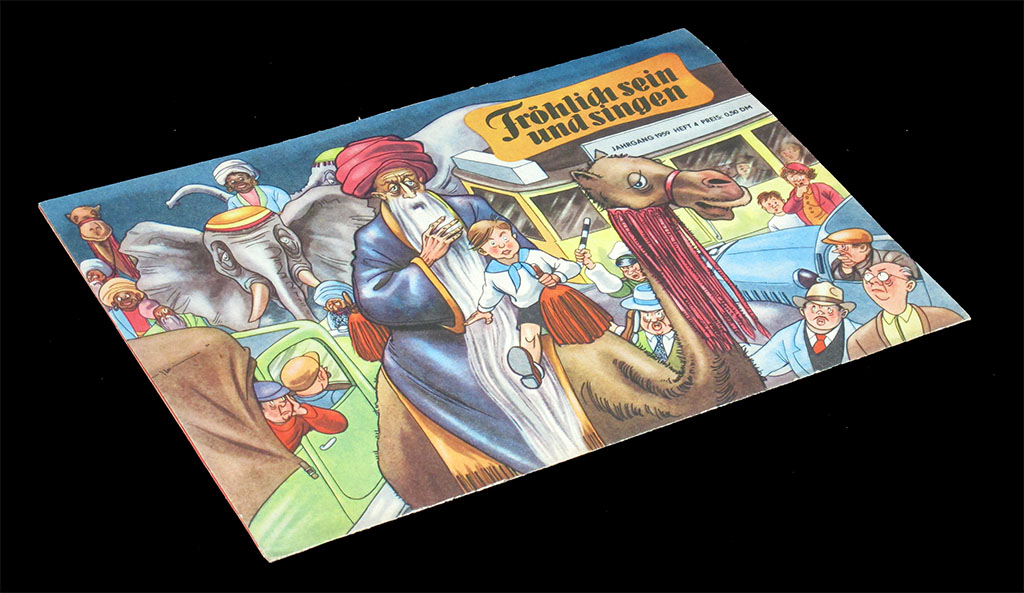
AUF DEN STRASSEN DES
FRIEDENS
Fröhlich sein und singen, East Germany, 1959

Here is another Friedensfahrt game. This one is called 'Auf den Straßen des Friedens' (on the roads of peace) and was included with issue 4/1959 of the monthly children's magazine "Fröhlich sein und singen". This magazine was renamed to "FRÖSI" in 1965, and that is the name by which it is remebered. It was published by 'Junge Welt', and it was the magazine for members of the pioneer organization Ernst Thälmann and its maximum circulation was of 600,000. The magazine had 32 to 40 pages, and the cover was a triple sheet of light cardboard, featuiring a double-page game.Breaking again my rule of not buying incomplete magazines, I have found that unfortunately the rules of this game were not printed on the back of the cover (as are on some other FRÖSI games. So all I can do is guess, or wait for someone who has the rules and is kind enough to send them.
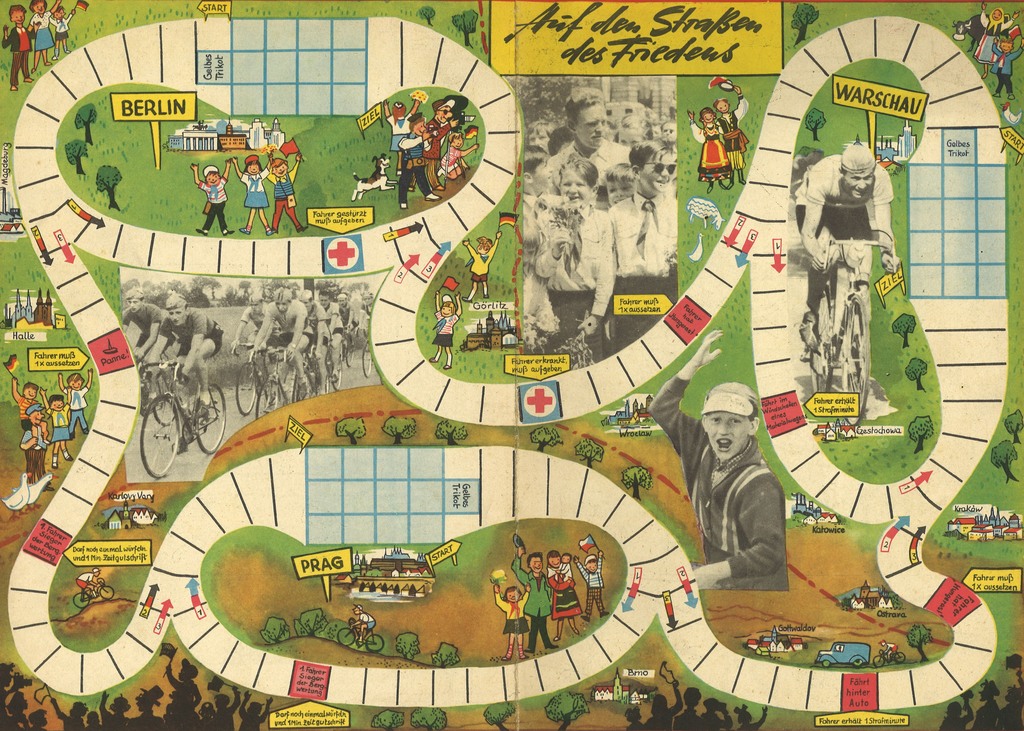
My guess is that being an Eastern-block game, players have a team of several riders (probably four, looking at the board) and it is more important to win the team competition than the yellow jersey (individual classment), but there is porobably a minor prize for the first rider to reach the finishing line.
Speaking of the finishing line, the 1959 Friedensfahrt ran from Berlin to Warsaw, but this is not obvious by looking at the board. The track is a closed circuit, and It looks like there are three starting points, each of which placed in a loop arount the three cities (the third is Prague, of course).
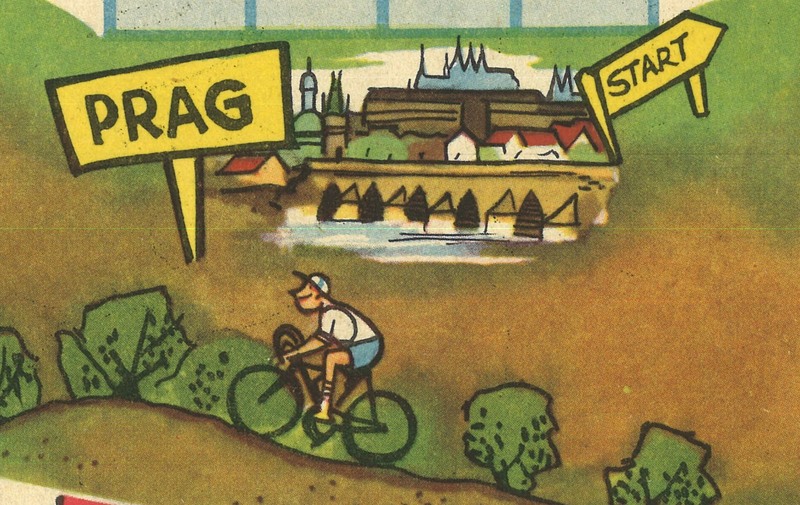
Around Prague
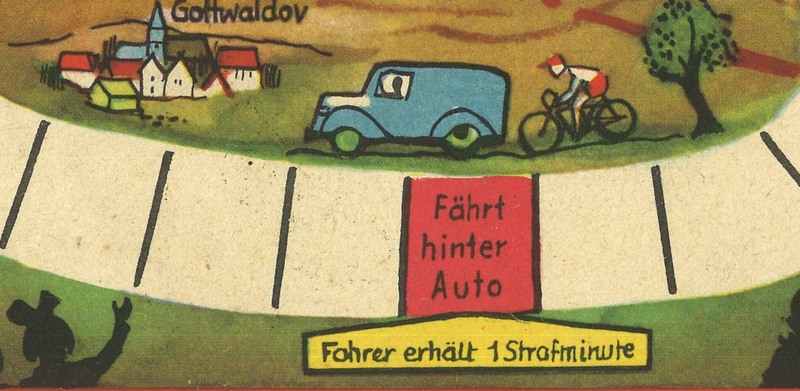
Penalty for being paced by a car.
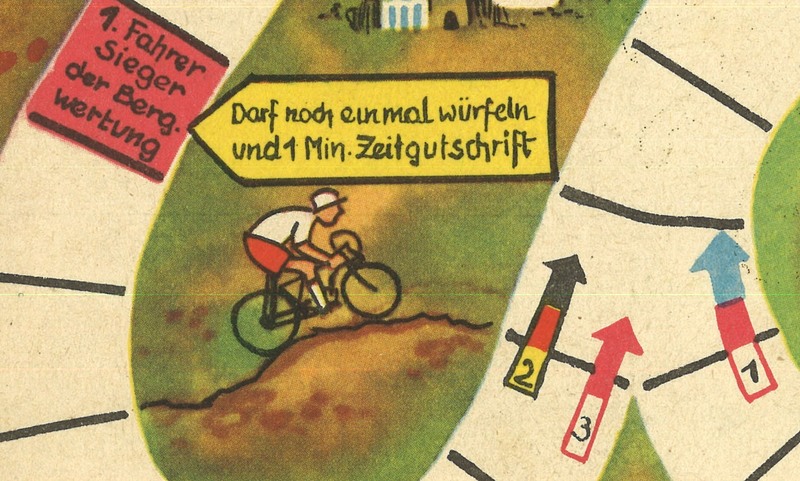
An then we find these mysterious arrows, in the colours of the German, Polish and Czechoslovakian flags.
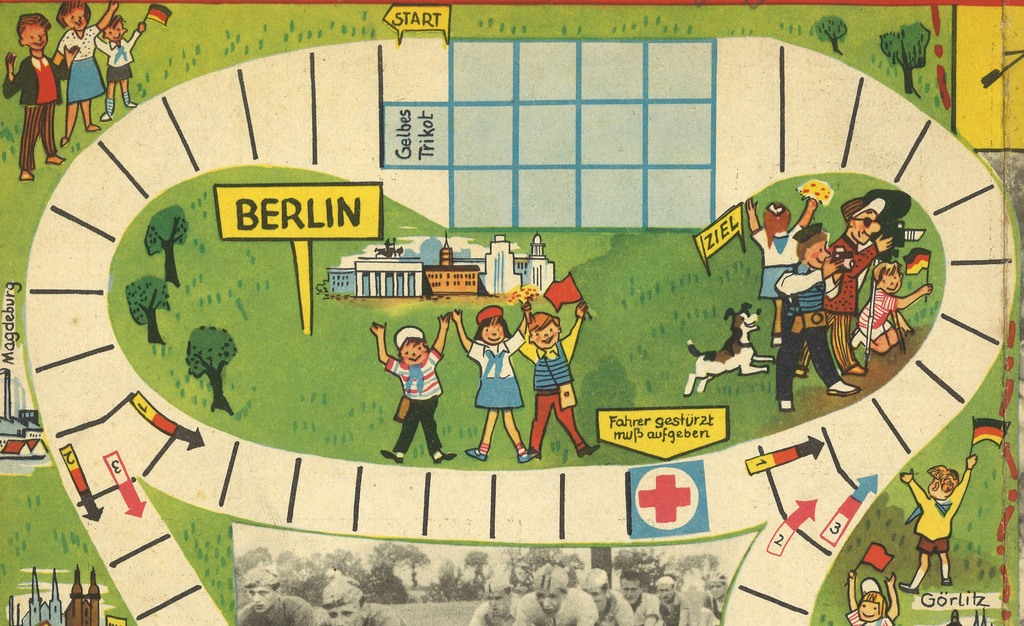
Flags numbered 1 to 3 appear at every intersection, but the colours of the flags are not easy to interpret.
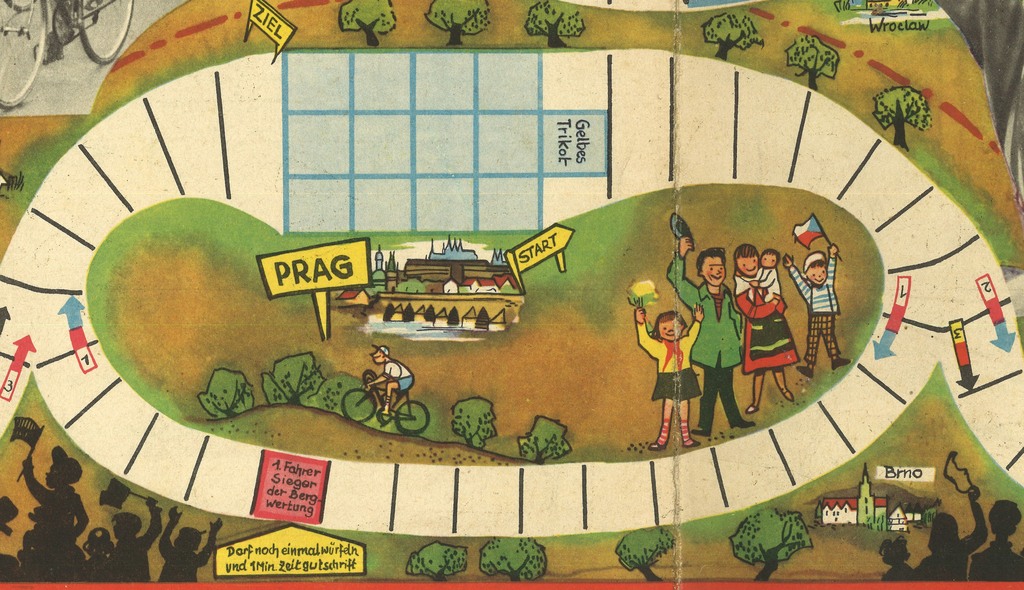
I observe that each country has flags numbered with a "1" around their main town, then with a "2" to the next destination and with a "3" to the other. This could mean that german riders first race around berlin, then to Prag and finally to Warsaw, while the Czechoslovakian race around Prague, then to Wassaw and then to Berlin, and the Poles do Warsaw-Berlin-Prag. But that is all I can say.
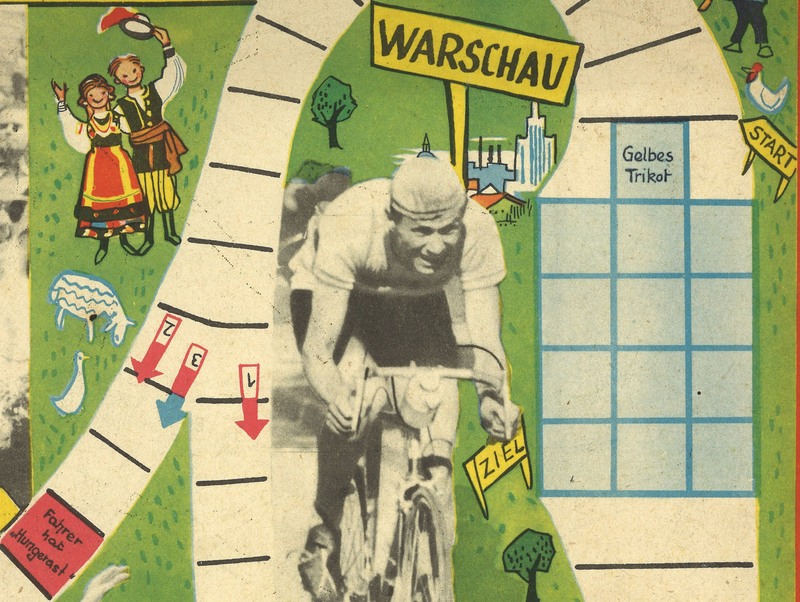
This is Täve Schur, a sporting hero in 1959's GDR, a controversial figure later.
In each town there is a 13 field grid, which is what makes me guess that the game is played by three players, each of which manages a team of four riders each. It is just a guess, but I am willing to bet on it!
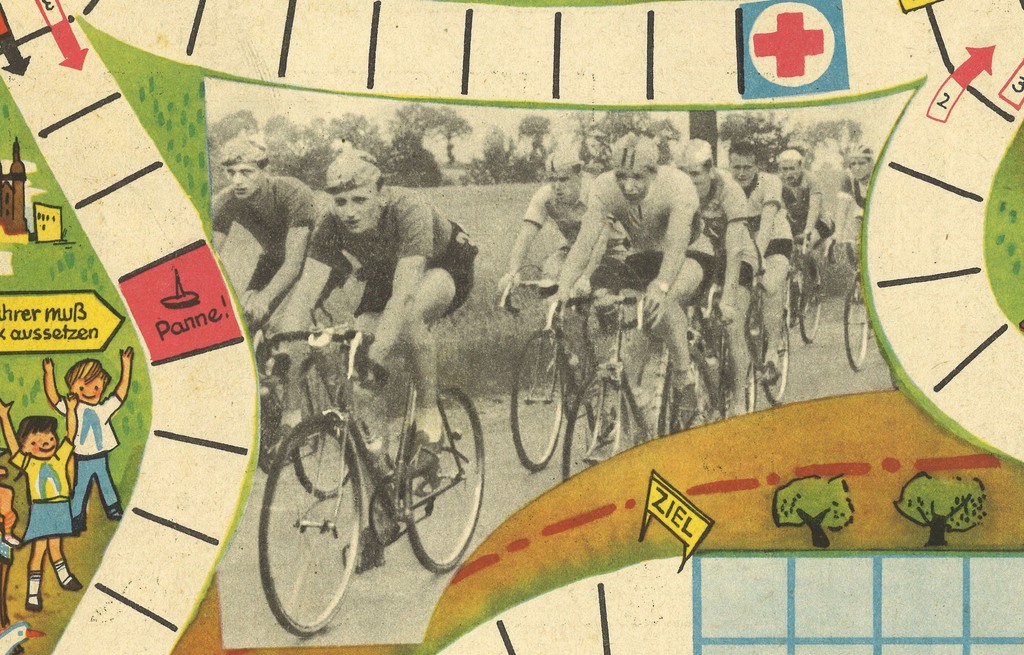
Then there is this weird mix of photographs and drawings, but it is not too bad after all.
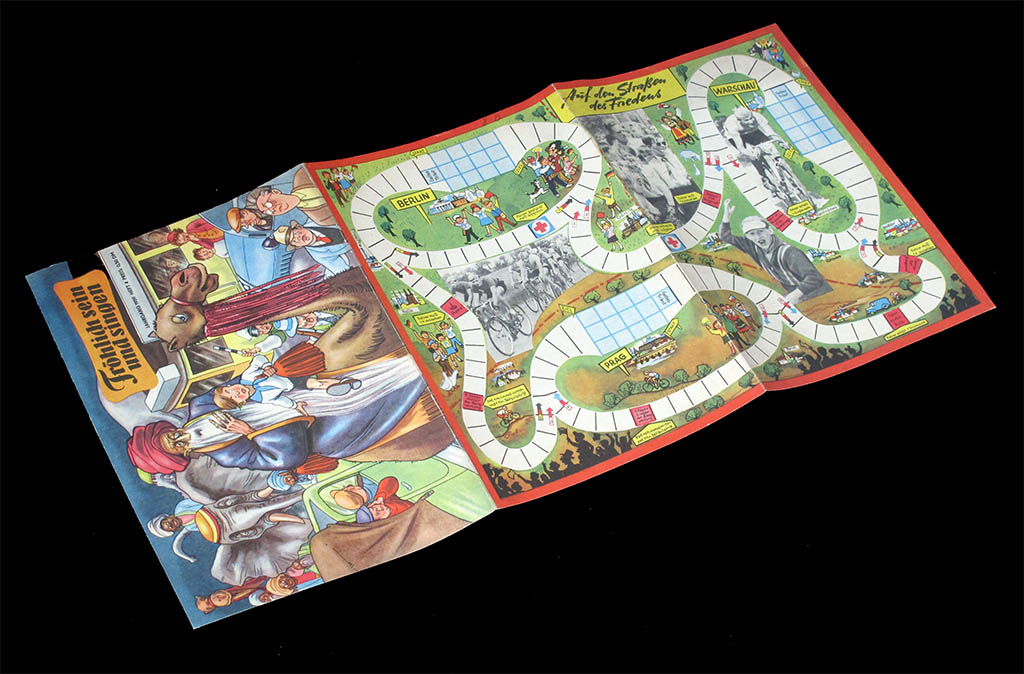
Double-page game and cover of the magazine (or maybew just the cover of the insert)
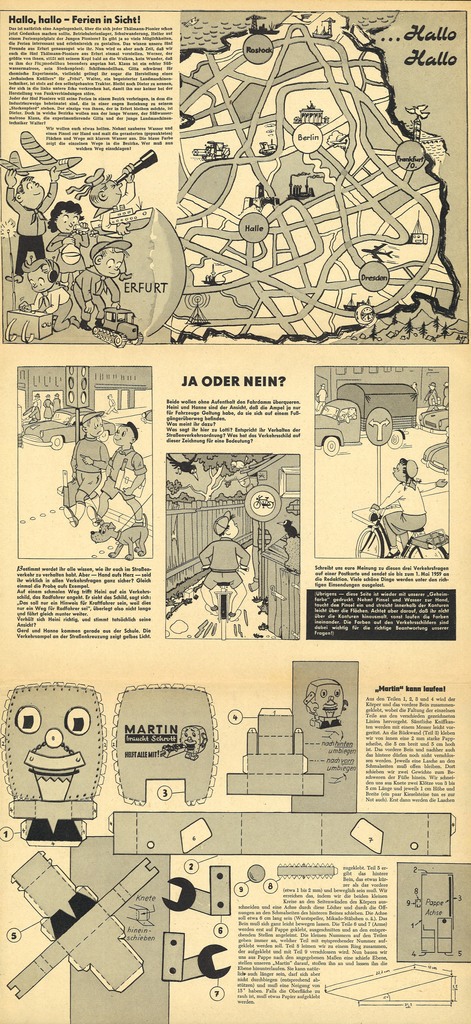
Unfortunately the rules are not printed on the back.
UPDATE JUNE 2023:
Siegfried L. has sent his comments and a set of proposed rules for this game.
He suggests that "the colors indicate the direction of the course. It depends on the starting place which arrows you have to follow. You can choose Berlin-Prague-Warsaw, Prague-Warsaw-Berlin or Warsaw-Berlin-Prague (all counter-clockwise). If you start in Berlin you have to follow the arrows in the colors of the German flag. The numbers simply indicate stages 1, 2 or 3. Stage 1 always ends in the starting city of the chosen course. If you start in Prague, the Friedensfahrt ends in Berlin. In this case there is no stage Berlin-Prague, so there is no arrow in Czech colors after leaving Berlin."
I guess that makes sense.
Siegfried also expresses his dislike for the way the photographs are pasted onto the original artwork, especially Täve Schur's hiding Varsaw's St. Kazimierz church.
Here are his proposed rules. In some things, they do not pretend to be like the original ones (which, by the way, I still have not found). For instance, if I were asked, I would say that the original game used only one die, while Sigfried argues that using two dice is the only way to prevent a massive "traffic jam" at the start, and that he feels quite sure that the game used two dice. On the other hand, he concedes that some details of the rules are not necessary to play the game, but he felt that a time trial and a simple drafting rule would give the game more "race feeling". So be it.
Proposed rules for "Auf den Straßen des Friedens" (FRÖSI magazine, 1959)
This peace race game can be played by 2-4 players. Every player leads a team of 4 riders (if there are 2 or 3 players) or a team of 3 riders (if there are 4 players). To play this game, you need the board, 2 regular 6-sided dice, and tokens to represent the riders (for example, 12 wooden pegs in four different colors). Moreover, one of the players needs a pen and paper, to keep track of the teams' penalty minutes and stage wins.
Before the game starts, players have to decide the starting city. The game can be played on 3 different peace race routes: Prague-Warsaw-Berlin, Warsaw-Berlin-Prague or Berlin-Prague-Warsaw. Every race has 3 stages. The route of the chosen race is indicated by arrows in the colors of the starting city's country. The numbers on the arrows indicate the numbers of the 3 stages. Note: If they like to, experienced players can choose different routes and race more than three stages.
The starting order of the first stage is determined by a "prologue time trial". Every player throws two dice. The player who scores the highest sum puts one of his riders on the square "Gelbes Trikot" ("yellow jersey"). The other players put one rider each on the next blue squares of the starting grid in the order of their scores (riders on the left-hand side of a line will move first at the start). If two players score the same sum, their order is decided by additional throws of the dice. In this way, the starting grid is completed in 2 or 3 additional turns.
In all 3 stages, riders move in the order of their position in the race, starting with the leading rider. The number of squares to be moved is given by the sum of 2 dice. Except the starting grid, where each line is considered to be one square, on each square there can only be one rider. If the intended square is occupied and the following square is unoccupied, the rider advances to that square. Otherwise, the rider is put back on the first unoccupied square prior to the intended one. After all riders have moved a new turn begins, starting with the rider who is now in the lead.
Special squares (indicated in red):
"1. Fahrer Sieger der Bergwertung" ("1st rider wins the mountain price"): The first rider who passes this square or ends his move on it may throw the dice and move once more in this turn. Moreover, his team is awarded a bonus of 1 minute."Fährt hinter Auto" or "Fährt im Windschatten eines Materialwagens" ("rider is drafting behind a car"): A rider who ends his move on such a square receives a penalty of 1 minute.
"Panne" ("puncture") or "Fahrer hat Hungerast" ("rider faces nutrition crisis"): A rider who ends his move on such a square must miss one turn.
Red cross: A rider who ends his move on such a square falls ("Fahrer gestürzt") or is taken ill ("Fahrer erkrankt") and has to resign from the race!
The unfortunate riders occupy the special squares until the end of the turn. Then riders who have to miss one turn are put beside the road (and put back after the end of the next turn). Riders who have to leave the race are removed from the board.
The finish line of each stage is indicated by the sign "Ziel" (blue squares are beyond the line). The first rider to cross this line is the stage winner. He is awarded the "yellow jersey" and put on the "Gelbes Trikot" square. The other riders are placed on the starting grid for the next stage in the order of their arrival. Riders who arrive in the same turn as the winner are not penalized. Teams whose riders arrive later receive a penalty of one minute for every turn a rider has been late. After the last rider arrives, the next stage begins.
At the end of the 3rd stage the winner of the final yellow jersey is awarded a bonus of 1 minute. If riders had to resign, their teams receive a penalty of 3 minutes for every unfinished stage (for example if two riders had to resign on the 2nd stage of Warsaw-Berlin-Prague, their teams will receive 6 minutes each).
The winner of the game is the player whose team has less penalty minutes. In the case of a tie, the winner will be decided by: (1st) the number of stage wins, (2nd) the final yellow jersey, (3rd) the king-of-the-mountains price or (4th) the ranking in the prologue time trial.
Siegfried L., 2023
You may want to try this game (don't you?).
Click here to download the board (JPG file, 5 MB, meant to be printed on a
A3 sheet). You will need a couple of dice and a dozen pegs or counters (or
cycling figurines if you have ones small enough). Of course, if you object to
communist propaganda, you may prefer to download
some other game ;-)
Thanks to Gordon for the information about this game.
Description updated in June 2023.
|
CULTURE |
TOTUM REVOLUTUM |
NAMES |
CATEGORIES |
WHAT'S NEW |